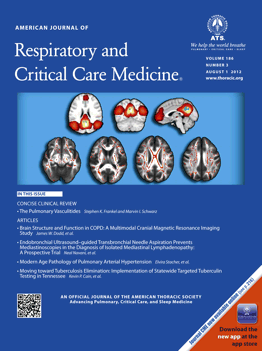 The American Journal of Respiratory and Critical Care Medicine (AJRCCM) has issued an Expression of Concern about a paper published online earlier this year, after concerns about the data prompted an investigation by the University of Nebraska.
The American Journal of Respiratory and Critical Care Medicine (AJRCCM) has issued an Expression of Concern about a paper published online earlier this year, after concerns about the data prompted an investigation by the University of Nebraska.
Here’s the notice:
As a result of an examination of the images, concerns arose regarding the data presented in several of the figures in the article by H. Li, S. Singh, S. Gorantla, R. Potula, Y. Persidsky, L. Poluektova, and G. D. Kanmogne, entitled: “Dysregulation of Claudin-5 in HIV-induced Interstitial Pneumonitis and Lung Vascular Injury: Protective Role of PPAR-γ,” published online, ahead of print on February 16, 2012 in the American Journal of Respiratory and Critical Care Medicine. The University of Nebraska has initiated an inquiry. At this time, we are holding the print publication of this article and will inform our readers of the outcome of the inquiry.
The University of Nebraska’s associate vice chancellor for academic affairs, Jim Turpen, tells Retraction Watch:
I can not comment further on an inquiry that is currently in progress. All proceedings are confidential. According to Federal Regulations we have 60 days to complete the inquiry process.
The research was funded by the American Lung Association and the U.S. National Institutes of Health.
We’ve contacted the corresponding author and the editor of the journal, and will update with anything we learn.
Update, 5:15 p.m. Eastern, 8/9/12: The journal tells us:
The concerns with the images in question came to our attention during a routine forensic analysis conducted as part of our editing process (articles are posted online before being edited). The specific concern was that some of the images appeared to have been manipulated. The author’s institution is investigating, and we will publish further details when we have them.
Hat tip: Clare Francis
Just from a very quick look there are obvious splicing in most of the blot figures. I’ll never understand how rubbish like this gets past the reviewers.
I wonder the same in my field!
I sometimes wonder whether the only reason microsatellite gels and RAPD gels and so forth are never found to be manipulated is that journals no longer publish photos of such gels when manuscripts are based on this kind of evidence. Computer-generated diagrams are wanted instead, these days. I’m not saying that space should be allocated for every single gel when dozens of gels were needed to handle all the samples, but a photo of a representative one, or even the best one, would establish whether the researcher is able to make a decent, scorable gel to support the numerical data that get fed into the computer. If your data are crap, your conclusions are crap.
Uh-oh… http://www.science-fraud.org/?p=333
Where there’s smoke there’s fire
The control epifluorescent image is also faked, the cells are out of focus, not negative.